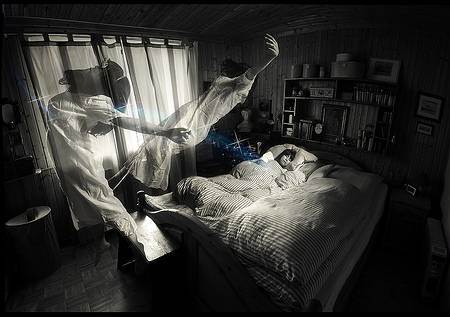
While scientists study the “mystical” out of body experiences and propose their theories, let’s try to explain what they are and where they come from, as well as how one can experience astral travel.
An “out of body experience” may be provoked by many different reasons, quite unpleasant ones: brain injury, sensory deprivation (lack of external stimuli), a near-death experience, the use of dissociative and some other drugs, artificial electrical stimulation of the brain, dangerous lack of sleep or dehydration, etc. However, Canadian neuroscientists led by Claude Messier found a 24-year-old student capable of experiencing it by a simple act of will. After studying the function of her brain, they found a lot of interesting things.
As the researchers themselves describe the girl’s unique abilities, “she can see herself spinning, lying or rolling on a horizontal plane in the air over her own body. It is reported that from time to time she can watch her body moving on, feeling that her “real” body remains motionless. According to the student, the emergence of such experiences is not connected to any particular emotional state.”
How is that even possible? To find out, the scientists tracked the brain activity of the girl using fMRI. As a result, the brain scan detected a marked reduciton of excitation in the visual cortex and increased activity in the areas associated with the creation of kinesthetic image od one’s own body, its position and movement in space.
It turns out that “out of body experience” is a very real thing. The 24-year-old student spoke the truth and really was able to call this state with the help of her willpower. But does this mean that her “soul” has unique gift to leave her own body? According to scientists, nothing paranormal and mystical is required for explanation of this phenomenon.
Today experts believe that all these astral travels are nothing more than a hallucination. They are caused by a small glitch in the coordination of neurons responsible for primary processing and synthesis of incoming information, which most likely leads to confusion between the visual and tactile stimuli that get in the higher centers of the brain. Roughly the same happens in cases of synesthesia when a stimulus “jumps” from one sensory system to another and leads to creating color sensaitons for sounds.
By the way, the Canadian neuroscientists believe that if one person has learned to call these “astral hallucinations” at will, why can’t the rest of us learn to do the same? If this skill dose not have any useful applicaiton, we could at least get a new amazing experience. Among the methods to prepare the mind for an out-of-body experience, a simple self-hypnosis technique can be used.
So, find a quiet place where you will not be disturbed. Sit or lie down, relax, close your eyes and imagine that your hands are touching an endless thick rope. Do not move, but imagine the process in detail, try to feel like moving your hands and fingers and touching the rope.
Once you have a clear image of that in your mind, start to climb up the rope. Feel the tension in your muscles. Do not try to see it visually, but only to feel it, just like if you were climbing up in the complete darkness. If you try hard, then pretty soon you will get out of your own body. Have your eyes mentally “open” (or at least open your “third” eye) and see yourself from a height.
